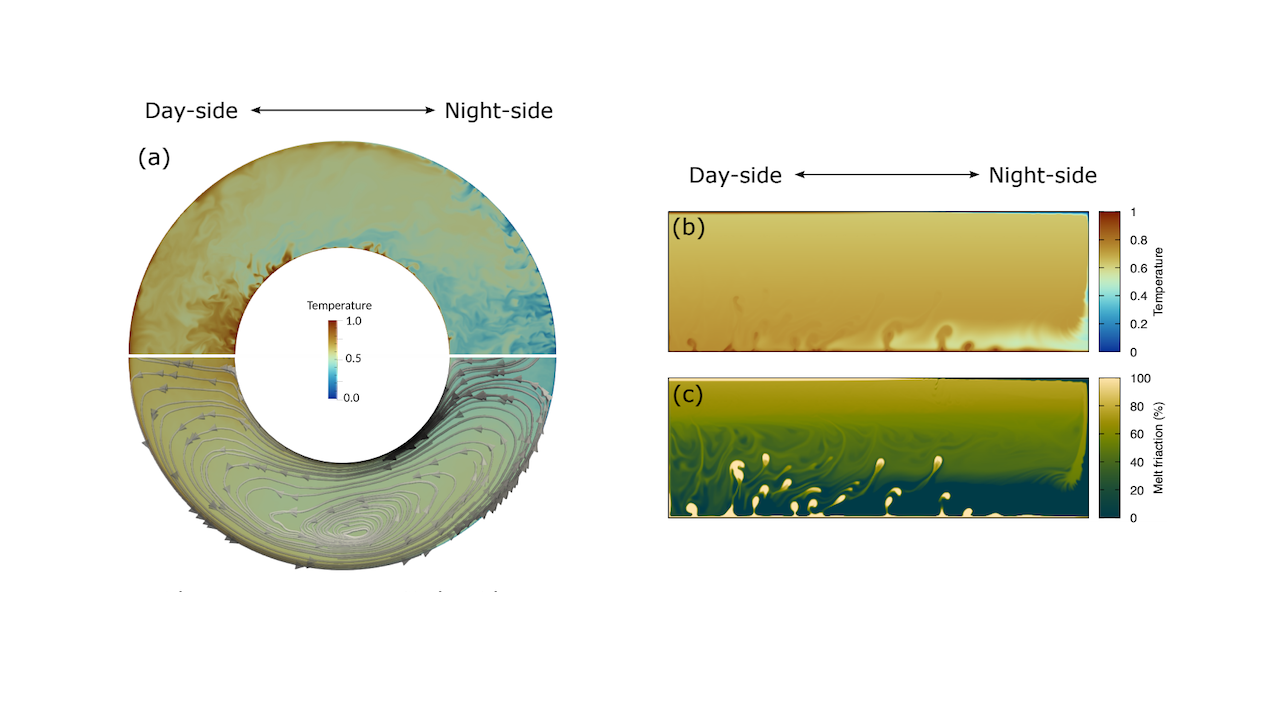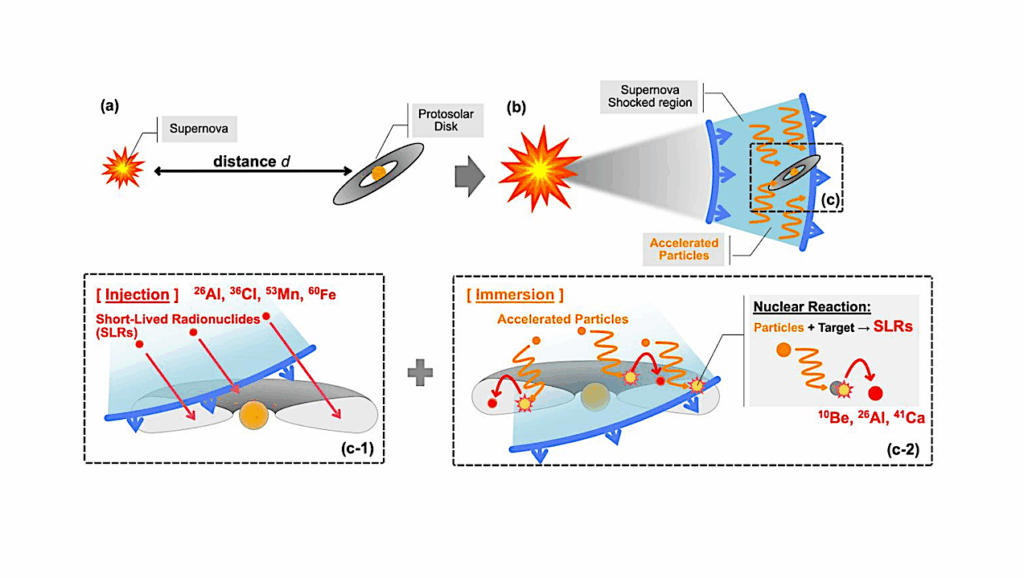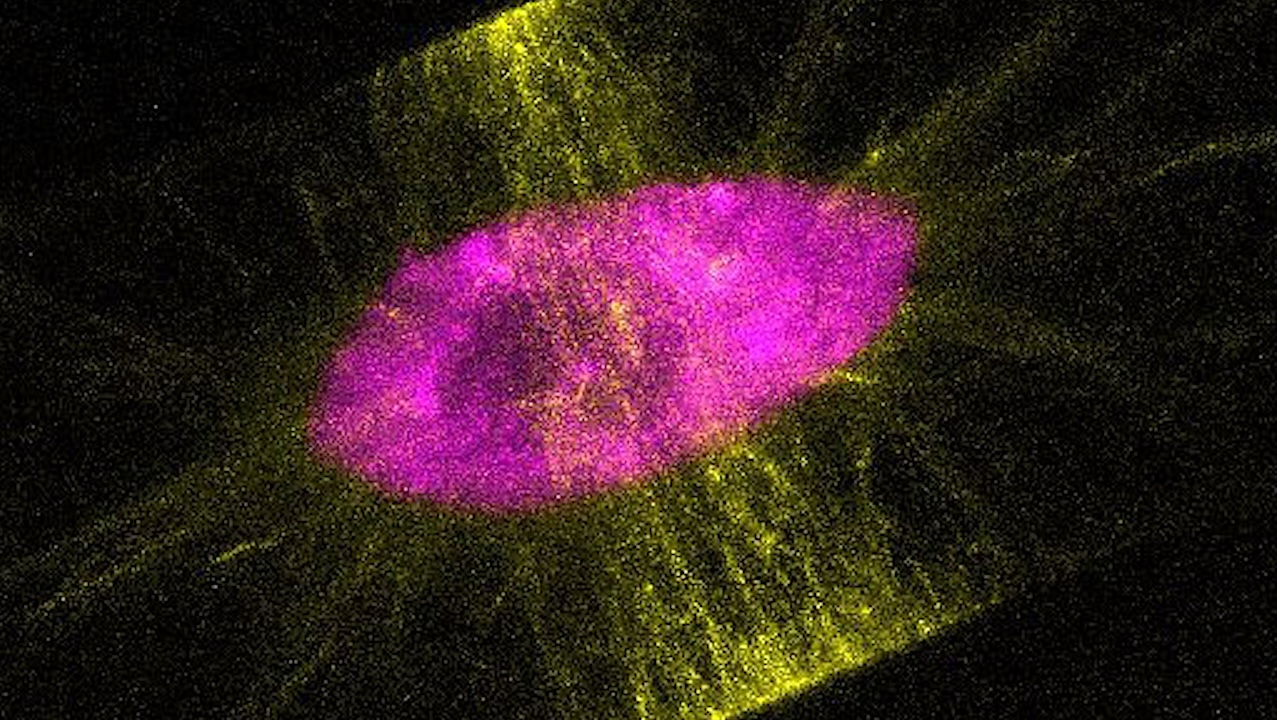Now Reading: The Role Of Interior Dynamics and Differentiation on the Surface and Atmosphere of Lava Planets
-
01
The Role Of Interior Dynamics and Differentiation on the Surface and Atmosphere of Lava Planets
The Role Of Interior Dynamics and Differentiation on the Surface and Atmosphere of Lava Planets


Numerical simulations of lava planets interior dynamics with no rotation. The dimensionless temperature scale is the maximum super-adiabatic temperature contrast: temperature is 1 at the base of the magma ocean, 0 at the surface on the night-side and 1 at the surface on the day-side. Panel (a) shows equatorial cross-sections from a turbulent model in spherical geometry with no phase change: the upper half is a snapshot and the lower half is a time average over 12 turbulent turnover times with superposed streamlines. Panel (b) shows temperature and panel (c) melt fraction from the 2D Cartesian model that accounts for solid–liquid phase change. See also Supplementary Video 1. — astro-ph.EP
Lava planets are rocky exoplanets that orbit so close to their host star that their day-side is hot enough to melt silicate rock. Their short orbital periods ensure that lava planets are tidally locked into synchronous rotation, with permanent day and night hemispheres. Such asymmetric magma oceans have no analogs in the Solar System and will exhibit novel fluid dynamics.
Here we report numerical simulations of lava planet interiors showing that solid-liquid fractionation in the planetary interior has a major impact on the compositional structure and evolution of the planet. We explored two styles of dynamics that depend primarily on the interior thermal state : 1) a hot fully molten interior, and 2) a mostly solid interior with a shallow day-side magma ocean.
In the hot interior scenario, the atmosphere reflects the planet’s bulk silicate composition and the night-side crust is gravitationally unstable and constantly replenished. In the cool interior scenario, the distilled atmosphere will lack Na, K and FeO, and the night-side mantle is entirely solid, with a cold surface. These two end-member cases can be distinguished with observations from the James Webb Space Telescope, offering an avenue to probe the diversity of terrestrial exoplanet evolutions.

3D simulations of global magma ocean dynamics accounting for rotation. Left panels show snapshots, while the right panels show time averages over 14 turbulent turnover times. The top panels show equatorial slices, while the bottom panels show meridional slices. In these simulations with a fully molten, turbulent magma ocean, rotation produces a longitudinal shift of downwelling and upwelling regions with respect to the antistellar and sub-stellar points, visible in panel (b). An asymmetry between the western and eastern hemispheres also develops in the bulk of the magma ocean. — astro-ph.EP
Charles-Édouard Boukaré, Daphné Lemasquerier, Nicolas Cowan, Henri Samuel, James Badro
Comments: 12 pages, 4 figures. Supplementary informations are included
Subjects: Earth and Planetary Astrophysics (astro-ph.EP); Fluid Dynamics (physics.flu-dyn); Geophysics (physics.geo-ph)
Cite as: arXiv:2308.13614 [astro-ph.EP] (or arXiv:2308.13614v2 [astro-ph.EP] for this version)
https://doi.org/10.48550/arXiv.2308.13614
Focus to learn more
Submission history
From: Charles-Édouard Boukaré
[v1] Fri, 25 Aug 2023 18:15:14 UTC (11,138 KB)
[v2] Tue, 20 May 2025 14:45:33 UTC (13,401 KB)
https://arxiv.org/abs/2308.13614
Astrobiology, Astrogeology,
Stay Informed With the Latest & Most Important News
Previous Post
Next Post
-
 012024 in Review: Highlights from NASA in Silicon Valley
012024 in Review: Highlights from NASA in Silicon Valley -
 02Panasonic Leica Summilux DG 15mm f/1.7 ASPH review
02Panasonic Leica Summilux DG 15mm f/1.7 ASPH review -
 03From Polymerization-Enabled Folding and Assembly to Chemical Evolution: Key Processes for Emergence of Functional Polymers in the Origin of Life
03From Polymerization-Enabled Folding and Assembly to Chemical Evolution: Key Processes for Emergence of Functional Polymers in the Origin of Life -
 04How New NASA, India Earth Satellite NISAR Will See Earth
04How New NASA, India Earth Satellite NISAR Will See Earth -
 05And Thus Begins A New Year For Life On Earth
05And Thus Begins A New Year For Life On Earth -
 06Astronomy Activation Ambassadors: A New Era
06Astronomy Activation Ambassadors: A New Era -
07SpaceX launch surge helps set new global launch record in 2024




















